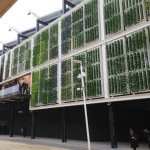The Future Of Food Is On The Table
The event, called Expo Milano 2015, is the latest World’s Fair. This year’s theme is “feeding the planet, energy for life.” The global population is projected to pass 9 billion by 2050, and Expo organizers want to start a global conversation now about sustainability, biodiversity and food security.
With exhibits from 145 countries over a 12-million-square-foot area, the expo is a showcase for the many cultures of food and environmental technology. Some pavilions have vertical farms.
One of the more low-key pavilions belongs to the Italian-born Slow Food movement. Since it was founded in the mid-1980s, Slow Food has contributed to a growing worldwide appreciation of artisanal food products and local food production.
Your “Organic” Strawberries Aren’t Really Organic
This is something I certainly didn’t know about, and comes as quite a shock to me. Certified organic strawberries aren’t  so organic after all; it turns out they are fumigated with toxic chemicals, including methyl bromide, at the beginning stages of their life-cycle. So why are we paying double, or even triple the price for organic strawberries? In my opinion, this is absurdly misleading to consumers who want to eat organic food.
so organic after all; it turns out they are fumigated with toxic chemicals, including methyl bromide, at the beginning stages of their life-cycle. So why are we paying double, or even triple the price for organic strawberries? In my opinion, this is absurdly misleading to consumers who want to eat organic food.
Methyl bromide, is used to sterilize the soil before strawberries are planted. It’s not sprayed on the fruit. It’s a soil fumigant that kills just about everything it touches. Many hybridized seed varieties have been created that can only grow in sterile soil. Even though top scientists have noted that this chemical is harmful to humans and the environment, it was approved for exclusive use in California in 2010 where almost 90% of strawberries are produced.
Wide Use of Antibiotics Allows C. Diff to Flourish
 I’ve been writing for years about the overuse of antibiotics, both in our animal husbandry, and in the frequency of doctors prescribing it, even for non bacteria illnesses, “just in case,” as if there are no side effects or down sides to the prescription. We have all been hearing about antibiotic resistant bacteria becoming more prevalent, but until someone you love contracts a resistant bacteria, it can take a back seat to everything else we are dealing with.
I’ve been writing for years about the overuse of antibiotics, both in our animal husbandry, and in the frequency of doctors prescribing it, even for non bacteria illnesses, “just in case,” as if there are no side effects or down sides to the prescription. We have all been hearing about antibiotic resistant bacteria becoming more prevalent, but until someone you love contracts a resistant bacteria, it can take a back seat to everything else we are dealing with.
Well, now this issue has become front and center for me, and I want to make sure you all know about it. Antibiotic resistant bacteria is becoming an epidemic, and the overuse of antibiotics is responsible for the epidemic!
Even if you think you are not at risk because you don’t take antibiotics, if you are eating non organic meat, chicken or dairy, you ARE ingesting antibiotics. Over 70% of the antibiotics used in this country go towards animals in feed lots, and when you eat them, the antibiotics go into your gut. Clostridium difficile or C-Diff is an intestinal bacterium that effects over 500,000 people and is responsible for over 30,000 deaths per year. Increasing fermented foods in our diet will help strengthen our gut, but staying away from antibiotics, and signing our petition to get antibiotics out of our food system, will also help.
Scientists Warn to Expect More Weather Extremes
Torrential rains and widespread flooding in Texas have brought relief from a yearslong drought to many parts of the  state. Such unpredictable and heavy rains are a big part of what climate scientists say that many Texans can expect in years to come.
state. Such unpredictable and heavy rains are a big part of what climate scientists say that many Texans can expect in years to come.
Reservoirs that had reached historically low levels are brimming, or at least rising fast. The water level at Lake Travis near Austin rose nearly 24 feet in the last week. It was just 34.2 percent full a year ago; today it is 65.5 percent full. Across the state, reservoirs have collected about eight million acre feet of water, rising to 82 percent full from 73 percent full in a month, according to the Texas Water Development Board.


Comments are closed.